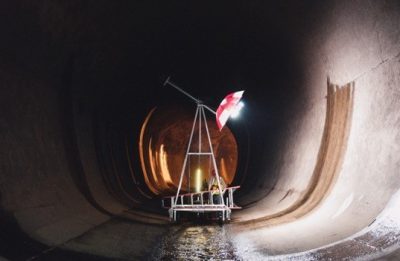Building a Better Inspection and Prediction Model for NB Power's Generating Stations
Author: Engineering Alumni Office
Posted on May 11, 2018
Category: Student Spotlight , Research Spotlight
Cody Bradley (BScCE’14) brought a couple of unique strengths to the table when he entered the Bachelor of Engineering program at UNB as a mature student in 2010: he had experience in the business world with a startup company, and he was a photographer and filmmaker.
These skills complemented those he would learn in the civil program, especially once he began working summers for Dr. Lloyd Waugh. Because of his photography background, Cody was able to help Dr. Waugh develop new virtual reality technology (VR Doc) for onsite documentation of construction projects.VR Doc enabled project participants to log on instantly from anywhere to examine project progress at any time and access panoramic views of the site, without travel or disruption to on-site staff.
After graduating, Cody went to work for two years as a geoenvironmental engineer in training for a Fredericton firm, but Dr. Waugh soon came calling. He convinced Cody to return to UNB to pursue a Masters Degree in Civil Engineering, and work with him on a new research project to take on-site photo documentation to the next level. Cody was interested in pursuing research that had practical applications with real industry clients, so he made the move back to UNB.
Over the last two years, Cody, under the supervision of Dr. Waugh, has been developing a new way to help NB Power document the condition of the intake tunnel at the Grand Falls Generating Station. There are four turbines in the Grand Falls generating station and a 1-km long, 7.5 m diameter tunnel constructed in 1926-1928 which has concrete and steel lined sections that direct water from the Saint John River. Until this project, NB Power had been inspecting the tunnel every four years using only flashlights and manpower to find any deterioration while the station was shut down for only a few days. The findings were manually charted in a spreadsheet and compared to the previous inspections. The challenges were obvious – it’s difficult to ascertain correct and full damage in the dark, in a time crunch, and when much of the defects tend to be in the crown of the tunnel, 18-19ft above eye level.
Glen Hanscom (BScCE’87, MScCE’98), a Civil Hydraulic Engineer at NB Power, needed a way to monitor and better predict deterioration in the tunnel so that a proper maintenance plan could be created and repairs could be more effective and efficient. That’s where Cody came in. He designed a photogrammetric inspection system that uses a robotic data acquisition system he calls TIA (tunnel inspection assistant). On this robotic assistant is a rotating boom that holds a camera and lighting so that photos can be taken of every inch of the tunnel in an efficient manner. The images captured by TIA are post-processed to generate a 3D model with a high-resolution image overlay.
In August of 2017, Cody, Lloyd and Glen spent just seven days on site in Grand Falls during a scheduled two-week shut-down for maintenance and repairs and captured over 5000 images using TIA (Cody estimates that, because of working out some initial bugs, the next scan would take only 2 days). The result was a 3D model of the complete tunnel with very high visual and spatial resolution and accuracy. The model, which NB Power can view using regular CAD software or through a custom interface designed for them, can interact with any part of the tunnel at any time and have much better data that will allow them to make efficient repairs and correctly predict needed maintenance.
The improvements of the 3D model in assessing current and predicting future condition in comparison to the traditional inspection was so impressive that NB Power asked to use the system at the Mactaquac Generating Station to document the discharge ring and draft tube of one of the turbine units, a space that was difficult to effectively assess in the past. Cody was able to capture over 500 images of the discharge ring and create a 3D model with 1.4 billion points at sub-millimeter resolution. A 3D model of the draft tube was also generated with millimeter resolution. “The time spent up front in planning and assessing a lot of different technologies to accomplish what we did was well worth it,” Cody explains. “We ultimately decided on this technology and method, and our client is happy. It’s very useful in the industry.”
Cody will be graduating this year from the master's program, and the Fredericton native must decide if and how he will pursue opportunities with the new technology. His prior business experience will come in handy. “What we’ve built is unique in visual resolution and usability. I’ve already had interest from utilities in the United States. Commercialization is something we’ll need to explore.”
